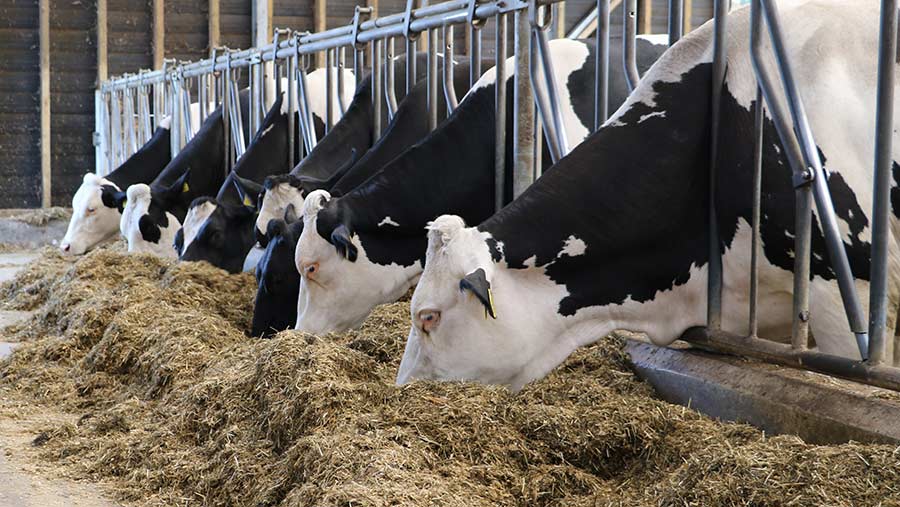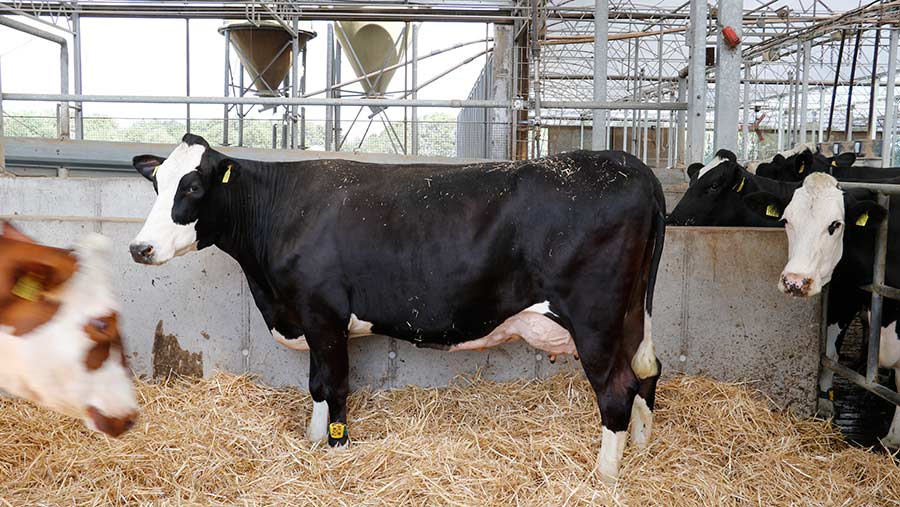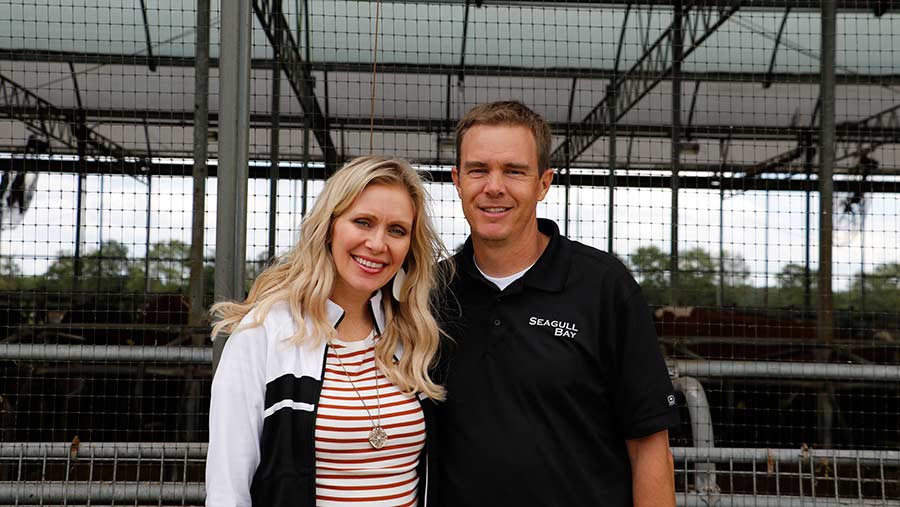Benefits of cross-breeding dairy and is it right for you?
 © Rhian Price
© Rhian Price Researchers at the University of Minnesota have been comparing the performance of three-way-cross cows (made up of Viking Red, Montbeliarde and Holstein) to Holsteins.
It differs from a similar study completed last year because it is the first to be conducted on commercial herds within the US.
Farmers Weekly was invited to a study tour in The Netherlands where the results where revealed and where an American dairy producer spoke about the benefits of cross-breeding.
The research
Three-way-cross dairy cows are more profitable than pure Holsteins, a 10-year study in the United States has concluded.
The trial, which was undertaken by researchers at the University of Minnesota across seven high-production herds in the state, is the first cross-breeding study to be conducted on commercial herds within the US.
It found two-way crosses produced the highest profits – 13% higher than pure bred Holsteins on average – while profits delivered by three-way crosses were 9% higher.
See also: Cross-bred cows v Holstein: How they compare
This was not down to higher daily production, with little difference seen in fat and protein production among the breeds.
Instead it was a cumulative effect stemming from improved longevity and therefore greater lifetime production, better fertility, fewer health treatments and higher calf and cull values.
The study found:
- Conception rates across three lactations averaged 33% for Holsteins compared with 39% for two-way crosses and 46% for three-way crosses.
- Two-way crosses averaged 12 fewer days open in comparison with Holsteins while three-way crosses averaged nearly 17 fewer days open across three lactations.
- Health treatments for both three-way and two-way breeds were £13-14 less compared with Holsteins (which averaged £58 over three lactations).
- The survival of two-way and three-way crosses was higher. Overall two-way crosses survived for an extra 158 days and three-way crosses lived for 147 days longer than Holsteins.
- Stillbirths among cross-bred cows were 2% lower, meaning farmers had more calves to sell.
Presenting the findings at the ProCross Summit in The Netherlands earlier this month, Professor Les Hansen, who led the research alongside Dr Amy Hazel and Professor Bradley Heins, said this resulted in greater profitability (see table).
Daily profit differences £/cow |
||||||
|
|
Holstein |
2-breed (VRxHO) |
2-breed MOxHO |
Holstein |
3-breed (VRxMO/HO) |
3 -breed (MOxVR/HO) |
|
Number of cows |
640 |
376 |
358 |
250 |
109 |
117 |
|
Income |
||||||
|
Production |
11.79 |
11.63 |
12.04 |
12.01 |
11.65 |
12.09 |
|
Calf value |
0.33 |
0.38 |
0.39 |
0.34 |
0.40 |
0.38 |
|
Cull value |
0.55 |
0.58 |
0.53 |
0.57 |
0.56 |
0.60 |
|
Total income |
12.67 |
12.60 |
12.96 |
12.92 |
12.61 |
13.07 |
|
Expense |
||||||
|
Total feed |
4.58 |
4.51 |
4.61 |
4.62 |
4.51 |
4.59 |
|
Lactation overhead |
3.33 |
3.29 |
3.31 |
3.34 |
3.31 |
3.33 |
|
Replacement cost |
1.27 |
1.16 |
1.05 |
1.27 |
1.07 |
1.15 |
|
Health treatment |
0.19 |
0.13 |
0.14 |
0.20 |
0.14 |
0.13 |
|
Breeding |
0.15 |
0.14 |
0.14 |
0.15 |
0.14 |
0.14 |
|
Total expense |
9.70 |
9.44 |
9.41 |
9.77 |
9.36 |
9.51 |
|
Daily profit (income-expense) |
2.97 |
3.16 |
3.55 |
3.15 |
3.25 |
3.56 |
|
Percentage difference |
|
6% |
19% |
|
4% |
13% |
| Note: Figures have been converted from USD to GBP at 1USD to 0.80GBP and decimals have been rounded up | ||||||
Prof Hansen added: “The improved performance of the cross-bred cattle resulted from a combination of hybrid vigour which gives the out-crossed animal better performance than the average of its parents.”
What is ProCross?
It is a three-way cross of Viking Red, Montbeliarde and Holstein used in rotation to maximise hybrid vigour.
The study has so far compared only two- and three-way crossed. Preliminary data on the effects of crossing animals back to Holstein showed slight gains in fertility in first lactation Holstein-sired ProCross animals compared with pure Holsteins.
Analysis revealed that conception rates were 3% higher in Holstein cross ProCross group at 46% at first service.
However, this was not as good as second- and third-generation animals.
Preliminary production data showed Holstein-sired ProCross produced 589kg less milk compared with the Holsteins at 12,254kg but only 11kg less fat and protein at 813kg.
Currently, a lower number of Holstein cross ProCross animals are milking in first lactation and therefore fewer have been compared. But Prof Hansen says more data will become available as more daughters enter the milking herd.
Is crossbreeding right for me?
Marco Winters, head of genetics at AHDB, said cross-breeding should not be entered into lightly.
“Cross-breeding does have a place but is not a silver bullet to all problems like it’s made out to be. Farmers have to go into it with their eyes wide open and understand what they are doing,” he said.
About the herds taking part
The study compared 2,300 ProCross and 2,000 Holsteins across the seven herds. Average production for December 2017 across the herds was 13,587kg of milk with 512kg fat and 426kg protein.
All herds were calving year-round and were fully housed in cubicles and fed a Total Mixed Ration (TMR).
Semen from high-ranking proven bulls was used for each mating; corrective breeding was carried out for conformation and Holstein matings were protected against inbreeding.
Before jumping in, Mr Winters said farmers should consider what issues they were trying to tackle. If improvements could not be made through management or better breeding, then cross-breeding might be considered.

© Rhian Price
He pointed to Irish studies showing that heterosis gains were most beneficial in poorer environments.
“So, for herds that have good management conditions, or which already achieve acceptable levels of performance, heterosis will be least beneficial,” he explained.
However, once they make the decision farmers needed to be fully committed and must select the right breeds.
“The more breeds you introduce, the more complex it becomes, and you have to be careful you maintain that rotation,” he said.
Tips for cross-breeding
- Take time to select the best breeds for your system.
- Use breeds that are making genetic progress so you can continue to use the best bulls year on year.
- Carefully select the best bulls from each breed for the traits you desire.
- Use the Spring Calving Index and Autumn Calving Index (SCI/ACI) to select bulls. These rank all bulls (regardless of breed) on one common base so farmers can compare them like for like.
Source: Marco Winters
Lifetime profitability and how it was calculated
Daily profit was calculated by dividing lifetime profit by the number of days within the herd.
Lifetime profit was estimated from the income (milk, calf and cull values) and expenses (all feed, replacement costs, breeding costs, hoof-trimming and carcass disposal) for each cow after first calving on a daily basis, providing they lived beyond 45 months.
Case study: Ben Andersen, Andersen Dairy Inc, Idaho
American dairyman Ben Andersen began cross-breeding 16 years ago in an attempt to lift poor pregnancy rates and reduce cow losses.
Ben, alongside his father and brother, originally milked 500 Holsteins under the Seagull Bay prefix, and has produced top genetics for AI studs including the bulls Seagull Bay Supersire and Seagull Bay Silver.
Farm facts
- 2700 cows across two units (milking and dry stock made up of about 80% ProCross genetics and the remainder Holsteins).
- Partner in Winstar Genetics implanting 450 embryos each month with the aim of breeding high genetic merit Holstein sires for stud.
- Winstar Genetics is a 6,000-cow dairy that carries out all of the IVF/embryo transfer. It uses embryos from Seagull Bay and has purchasing rights over the genetics, with the remainder going back into the Andersens’ herds.
- 324ha owned.
- Buy in about 80% of their feed and have agreements with neighbours for taking compost and manure.
But, not content with the herd’s fertility and high culling rate, they began looking at other options.
They started crossing to Jersey in 2003 but weren’t “completely convinced” because of the high variation in cow size and low bull calf values.
After visiting a ProCross herd in California they took the decision to cross-breed the whole commercial herd, later discontinuing Jersey semen and opting for the Holstein cross Montebeliarde cross Viking Red.
They still run a small number of elite Holsteins for their genetic programme but Mr Andersen said they were so impressed with the results that they had increased the number of ProCross animals and had been rewarded with better herd performance.

Ben Andersen with his wife Robbie © Rhian Price
He admitted this was not all down to genetics and said better management had also played a role.
Stillbirths had decreased primarily because of management, with 24-hour monitoring, although little assistance was required, he explained.
Pregnancy rates have risen by 15% since the introduction of a pre-synch programme in 2016.
Although Mr Andersen conceded that using synchronisation protocols might not be a long-term answer and could be banned at some point, he believed it was possible for his herd to achieve 30% using monitoring protocols.
Heifers are bred three times to sexed semen before being served to beef while 75% of the cows are also AI’d to beef sires.
Breed comparison
The family has been comparing performance of the commercial Holsteins and ProCross, and Mr Andersen admitted the results had been surprising.
“I anticipated when we started this journey we would decrease in production and increase in health and fertility,” he said. “To my surprise we haven’t given up production.”
The June milk records show 592 Holsteins averaged 37.8kg of milk while 713 G2 ProCross (Holstein cross Montbeliarde) averaged 37.9kg and 493 G3 (Holstein cross Montebeliarde cross Viking Red) averaged 38.5kg. All were at 4.1% butterfat and 3.2% protein.
He said the gains in fertility were saving him money, with a 10% difference in pregnancy rate of the Holsteins and G1 and G2 animals (31.7% compared with 41-42%).
The ProCross cows are also eating 2kg less feed per day.
Feed efficiency is important, given that the farm buys in 80% of its feed for the dairy, including silage, alfalfa, soya and flaked maize. With price volatility increasing and only 324ha owned, it is a worry for the future of the enterprise.
“It is a concern. It worked well [buying in feed] for a long time in the west but there’s concern because of the volatility of the markets,” Mr Andersen said.
Herd performance improvements at Andersen Dairy |
|||
|
|
2002 |
2016 |
2019 |
|
Cow deaths |
10% |
5.5% |
3.7% |
|
Stillbirths |
10% |
4.5% |
3.6% |
|
Left Displaced Abomasum |
3.5% |
0% |
0% |
|
Culling rate |
40% |
35% |
28% |
|
Pregnancy rate |
12-16% |
23-27% |
36-40% |
